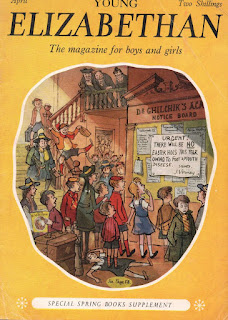I wonder if anyone reading this remembers The Elizabethan (originally The Young Elizabethan), a 'magazine for teenagers' that flourished from the mid-Fifties to the mid-Sixties and finally expired in 1972? I was only aware of it because I knew that some of Nigel Molesworth's musings on life at St Custard's and beyond appeared in its august pages (mediated by Geoffrey Willans and Ronald Searle). My parents would never have shelled out two shillings a month for a magazine, and neither was I inclined to when there were so many other calls on my pocket money (mostly sweets and Airfix kits I couldn't build). The future Mrs Nige, however, being of a more serious turn of mind, was a regular subscriber to The Elizabethan.
So, when I saw a pile of Elizabethans, mostly from the late Fifties, in a local charity shop the other day, I was curious enough to buy a few. And what a long-lost world this high-toned 'magazine for teenagers' opens up – a world of intelligent and highly literate youngsters (it was aimed at grammar school pupils) with interests that ranged from books (above all books) to world affairs, astronomy, model-making, nature, history, cycling, photography and ponies: one of the issues I bought advertised a Heinz 'Cowboy's Breakfast' colouring competition with three ponies on offer as prizes. If you didn't want the pony, you could opt for 200 guineas (yes, guineas) in Premium Bonds.
There is not a whiff of celebrity (in the modern sense) or fashion or gossip in these pages, and the only concession to pop music is a monthly record round-up by Sandy (The Boy Friend) Wilson. The excellent book page is written by Noel Streatfeild, famous as the author of Ballet Shoes – and talking of ballet, one of my issues has a photo spread of up-and-coming ballerinas, all very elegant and ladylike, a far cry from today's stringier, more gymnastic dancers. The same issue contains an interview with the eminent Nigel Calder on the future of space travel (which 'may unite the world as nothing has done before'); a piece on art auctions by the Daily Mail's Art Critic – they had one then; Nigel Molesworth on a shopping trip with his imperious grandmother; part three of Mist over Athelney by Geoffrey Trease, a historical novel set in the time of King Alfred; a piece by Tom Pocock on the life of a foreign correspondent; and an account of the sinking of the Birkenhead.
Another of my issues has a fine piece on Venice by James (now Jan) Morris. This, like everything in The Elizabethan, is writing at a high level, with no condescension to the young audience, who clearly needed no talking down to. The writing competitions are pitched at a level not far below the New Statesman or Spectator, but with less humour, and there are picture and (decidedly challenging) crossword competitions every month. The letters page is pitched as 'Your Questions Answered' – often questions about pursuing interests and career possibilities, finding pen friends, getting book recommendations and information. One letter asks for Dame Margot Fonteyn's address, another – from Elizabeth de Vere Stacpoole of Harrow-on-the-Hill (presumably a relative of the author of The Blue Lagoon) – asks how to get information about fencing classes. Yes, this is decidedly a middle-class, educated, self-improving and polite world.
The adverts – always the best guide to a magazine's readership – tell their own story: book announcements galore, ads for artists' materials, model aircraft, bicycles, ski wear and riding kit, adverts for other magazines such as Pony, The Tail Wagger Magazine and Opera (!,), Kangol berets, classical LPs, Bovril, a home weaving loom (weave your own stole!). Yes, another world, and one long gone. What would a 21st-century equivalent of The Elizabethan look like? Just to ask the question is to realise how impossible it would be. Those days – when teenagers were still, to a large extent, a combination of miniature adults and oversize children – are gone for good. I'm glad to have caught the tail end of it – even if I never subscribed to The Elizabethan.
Subscribe to:
Post Comments (Atom)


Jan Morris one of the very best writers on Venice. Her, perhaps final, book - 'Trieste and the Meaning of Nowhere' looks intriguing too.
ReplyDeleteThis comment has been removed by the author.
ReplyDeleteYes I keep meaning to get the Trieste book...
ReplyDeleteI haven't read it but bought it for a friend whose late Italian (Genoese) mother met his soldier father there in the free allied area during WW2. During my sojourn in Venice last year I visited Trieste by train and witnessed, as I had indeed done in Venice, evidence of separatist movements in play. The Triestini in question had placards demanding the reinstitution of the "Free" area in Trieste. All of this in the context of Catalonia, Lombardia etc of course. Here's a link to a little (very little) thing I wrote on my separatist encounter in Venice. http://roseatetern.blogspot.co.uk/2016/10/letter-from-venice-18-22-10-16.html
ReplyDeleteThanks for that Guy - strong secessionist feeling seems to be sweeping most of Italy these days (all the more viable regions, so not the South of course). Meanwhile the dear old EU charges forward in the opposite direction - it's surely only a matter of time till the whole thing collapses under the weight of reality. However, that time could be very long..
ReplyDelete